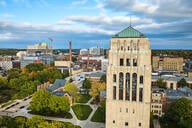You have /5 articles left.
Sign up for a free account or log in.
The 2007 mass killings at Virginia Tech continue to define for many the risk of violence in higher education. In an earlier generation, the relevant incident might be the deadly shooting in 1966 from the tower at the University of Texas at Austin. Much of the discussion about these tragedies and efforts to protect students assumes that campuses are residential, serve traditional-age undergraduates and have significant resources for counseling and identifying students who may be a danger.
While incidents continue to take place at campuses that fit those characteristics, the last week was an illustration that community colleges can also be the site of shootings or attacks -- and may face particular challenges in preventing such tragedies.
On Friday, authorities said that a student at New River Community College shot two people at the college's branch located in a shopping mall about 20 miles away from the main campus. While those shot haven't been officially identified, local journalists are reporting that one is a student at the college and the other a part-time employee. Both remain hospitalized and in stable condition. New River Community College is in the same part of Virginia as Virginia Tech.
Last Tuesday, a student at Lone Star College -- a community college in Texas -- was charged with stabbing 14 people there. Three people were shot in another incident at Lone Star in January.
Also in January, three people were killed in shootings at Hazard Community and Technical College, in Kentucky, in a shooting that appeared to involve a custody dispute involving two people who had no college affiliation but met so that one could hand over their child to the other at the college.
In December, two faculty members were killed at Casper College, a community college in Wyoming, by the son of one of them, who attacked his father in front of a class of students.
Much is dissimilar about these incidents, but experts say that they point to some common issues facing community colleges that present challenges different from those facing some four-year institutions. And while none of these incidents, thankfully, had the death tolls of Newtown or Virginia Tech, all of the incidents could have been worse and all left students and employees anxious.
S. Daniel Carter, a longtime advocate for increased vigilance to prevent campus crime and director of the 32 National Campus Safety Initiative (organized by families of those killed at Virginia Tech), said the New River shootings on Friday reflected one of the issues facing community colleges: numerous branch campuses. While four-year colleges have branches too, the mission of community colleges -- focused heavily on assuring access to students -- leads many to open relatively small branches, sometimes with just a few classrooms.
In many cases, Carter said, colleges may rely on security at the facility where space is being rented, rather than having their own security force. And colleges may have less of an ability to set rules for a facility that is shared with others than a college would on its main campus. He has received many questions over the years from colleges trying to determine the requirements for federal crime reporting, and small off-campus locations are the cause of much confusion.
Mark Rowh, vice president for workforce development and external relations at New River, said in an interview Sunday that the college has in fact relied on mall security for its site there. He said that one advantage the college found to creating an off-campus site in mall space that was previously a movie theater was the availability of services -- security, parking and so forth -- that the college didn't need to finance. He added that local law enforcement responded to the shooting within five minutes of when it took place.
Carter said that he didn't know specifics of last week's incidents but that they were a clear reminder that community colleges need threat assessment teams -- including psychology experts -- in place and ready to evaluate situations just as much as residential or four-year colleges need such teams.
Many counselors at community colleges report that their numbers are insufficient. A survey released last year by the American College Counseling Association’s Community College Task Force found that only 7 in 10 community colleges have threat assessment teams. Further, the survey found that counselors at community colleges not only have much higher student-to-counselor ratios than do their counterparts at four-year institutions, but they have many more responsibilities. The study found that 70 percent do academic advising, 68 percent do career counseling and 49 percent have administration or management duties.
The American Federation of Teachers last week charged that Lone Star is a good example of a community college failing to invest properly in counseling services. A statement issued by Randi Weingarten, president of the AFT, said that there were only three counselors working on the campus where the stabbings took place (a campus with 18,000 students). When the campus opened in 2003, it had 6,000 students and seven counselors. (Lone Star officials did not respond to requests for comment on the numbers or the AFT statement.)
"We shouldn't expect academic counselors to substitute for laid-off trained mental health counselors, as Lone Star College does. An important component of school safety is not just commonsense gun control measures but sufficient mental health services," Weingarten said.
Rowh said that New River does not have a regular counseling staff at the mall site, but that counselors from the main campus "rotate" to the mall location. About 1,300 of the college's 5,000 students take courses at the mall. He also said that there had been "no signs" prior to Friday that the student who has been charged in the shootings posed a threat to anyone. (Minutes before the shootings, the student apparently announced his intentions online.)
New River has been fortunate, Rowh said, that counselors from other colleges in the area have volunteered to help deal with the extra needs for counseling right now. Among them are counselors from Virginia Tech.




